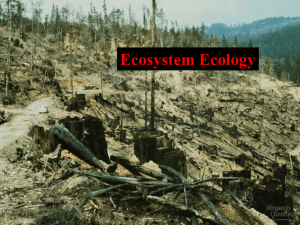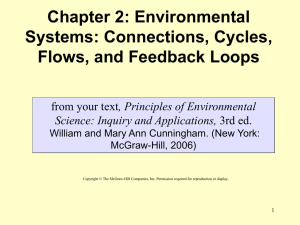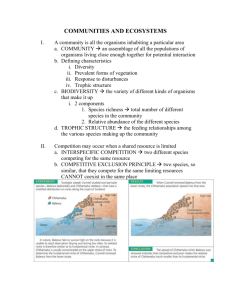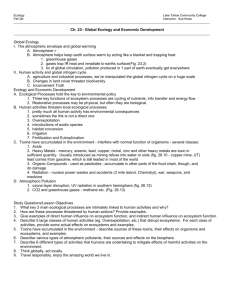Ch 7-18-19 - Ltcconline.net
advertisement
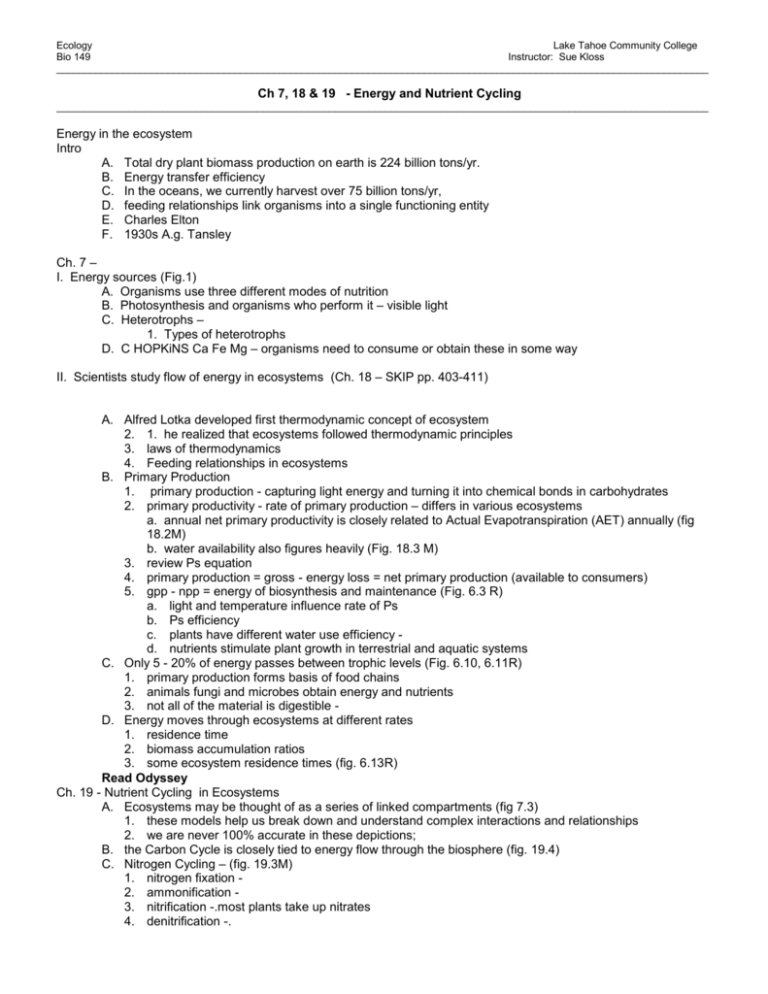
Ecology Lake Tahoe Community College Bio 149 Instructor: Sue Kloss _____________________________________________________________________________________________________________________ Ch 7, 18 & 19 - Energy and Nutrient Cycling _____________________________________________________________________________________________________________________ Energy in the ecosystem Intro A. Total dry plant biomass production on earth is 224 billion tons/yr. B. Energy transfer efficiency C. In the oceans, we currently harvest over 75 billion tons/yr, D. feeding relationships link organisms into a single functioning entity E. Charles Elton F. 1930s A.g. Tansley Ch. 7 – I. Energy sources (Fig.1) A. Organisms use three different modes of nutrition B. Photosynthesis and organisms who perform it – visible light C. Heterotrophs – 1. Types of heterotrophs D. C HOPKiNS Ca Fe Mg – organisms need to consume or obtain these in some way II. Scientists study flow of energy in ecosystems (Ch. 18 – SKIP pp. 403-411) A. Alfred Lotka developed first thermodynamic concept of ecosystem 2. 1. he realized that ecosystems followed thermodynamic principles 3. laws of thermodynamics 4. Feeding relationships in ecosystems B. Primary Production 1. primary production - capturing light energy and turning it into chemical bonds in carbohydrates 2. primary productivity - rate of primary production – differs in various ecosystems a. annual net primary productivity is closely related to Actual Evapotranspiration (AET) annually (fig 18.2M) b. water availability also figures heavily (Fig. 18.3 M) 3. review Ps equation 4. primary production = gross - energy loss = net primary production (available to consumers) 5. gpp - npp = energy of biosynthesis and maintenance (Fig. 6.3 R) a. light and temperature influence rate of Ps b. Ps efficiency c. plants have different water use efficiency d. nutrients stimulate plant growth in terrestrial and aquatic systems C. Only 5 - 20% of energy passes between trophic levels (Fig. 6.10, 6.11R) 1. primary production forms basis of food chains 2. animals fungi and microbes obtain energy and nutrients 3. not all of the material is digestible D. Energy moves through ecosystems at different rates 1. residence time 2. biomass accumulation ratios 3. some ecosystem residence times (fig. 6.13R) Read Odyssey Ch. 19 - Nutrient Cycling in Ecosystems A. Ecosystems may be thought of as a series of linked compartments (fig 7.3) 1. these models help us break down and understand complex interactions and relationships 2. we are never 100% accurate in these depictions; B. the Carbon Cycle is closely tied to energy flow through the biosphere (fig. 19.4) C. Nitrogen Cycling – (fig. 19.3M) 1. nitrogen fixation 2. ammonification 3. nitrification -.most plants take up nitrates 4. denitrification -. E. Phosphorus cycle (Fig. 19.2M) imp. in nucleic acids, cell membranes, bones and teeth 1. plants take up P 2. animals excrete phosphate salts in urine 3. bacteria 4. phosphate enters atmosphere 5. phosphorus in soils 6. in aquatic systems, phosphorus binds with iron or calcium Ch. 7, 18, 19 1. Give examples of 3 ways that humans are consuming much of the world’s annual productivity. 2. Name and describe the 3 modes of nutrition found in earth’s organisms, and examples of organisms who use each. 3. What is carbon fixation? Name 3 photosynthetic pathways, and generally speaking, describe how they differ. 5. Distinguish between a food chain and a trophic level. Give 2 or 3 general characteristics of each trophic level. 6. Distinguish between net primary productivity and gross primary productivity. 8. What is AET and how does it relate to net primary productivity? 9. About how much available sun energy is captured in photosynthesis? What happens to the rest of it? 10. Distinguish between a food chain and a food web. Draw one of each using organisms you know. 11. Define the trophic levels in your food web. 12. What are the 2 laws of thermodynamics? 13. Which law of thermodynamics is most useful in helping to explain a pyramid of energy? Briefly explain. 14. What and where are the losses in an energy pyramid? Where do the losses from one trophic level to another go? 15. Draw one of the major biogeochemical cycles (N, C, P). Put a short comment at each source or sink. 16. Describe Liebig’s law of the minimum and describe how it relates to soil fertility. Also describe how Liebig’s idea is modified in our current understanding. 17. Explain why energy losses occur in an ecosystem using a pyramid of energy, and how these losses limit trophic levels in ecosystems.
